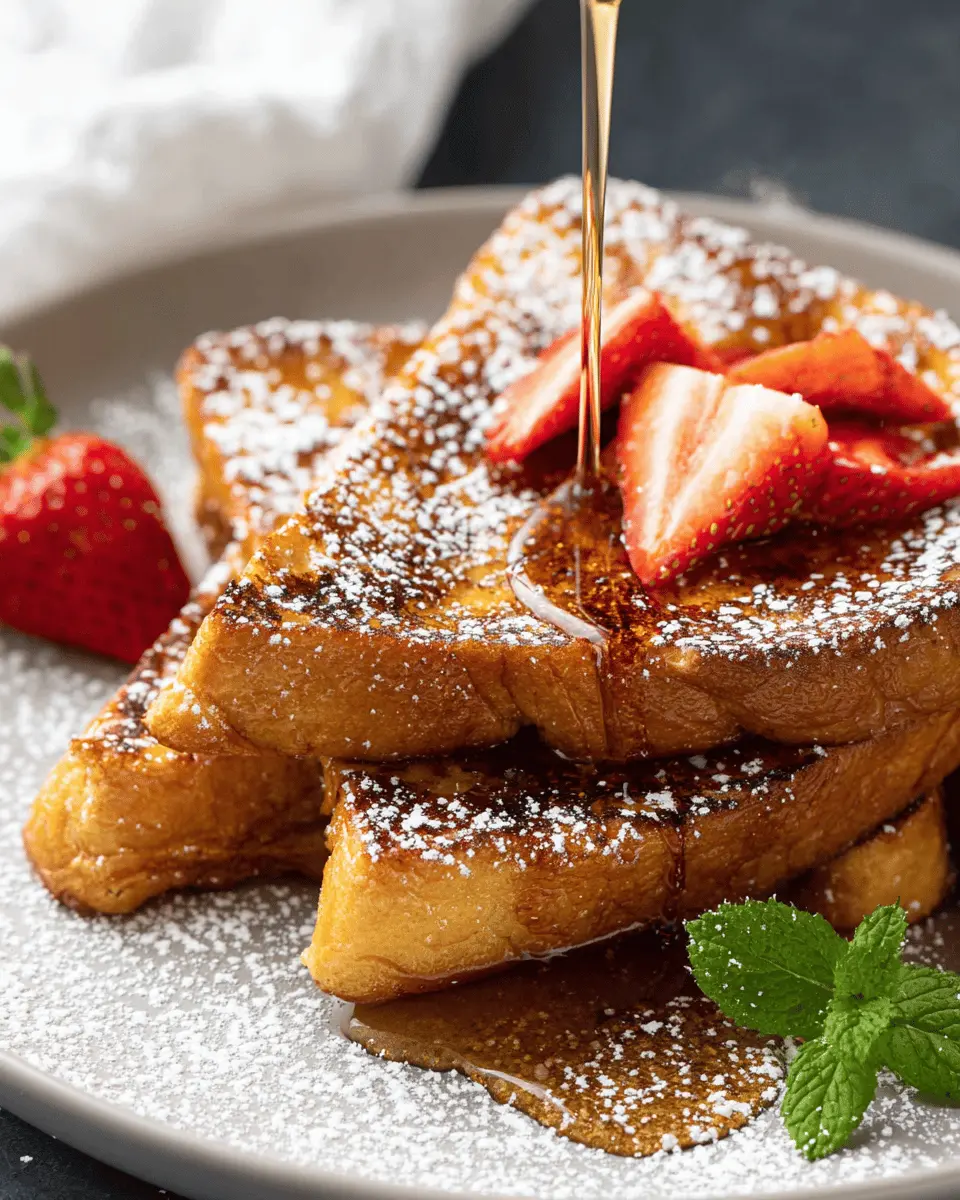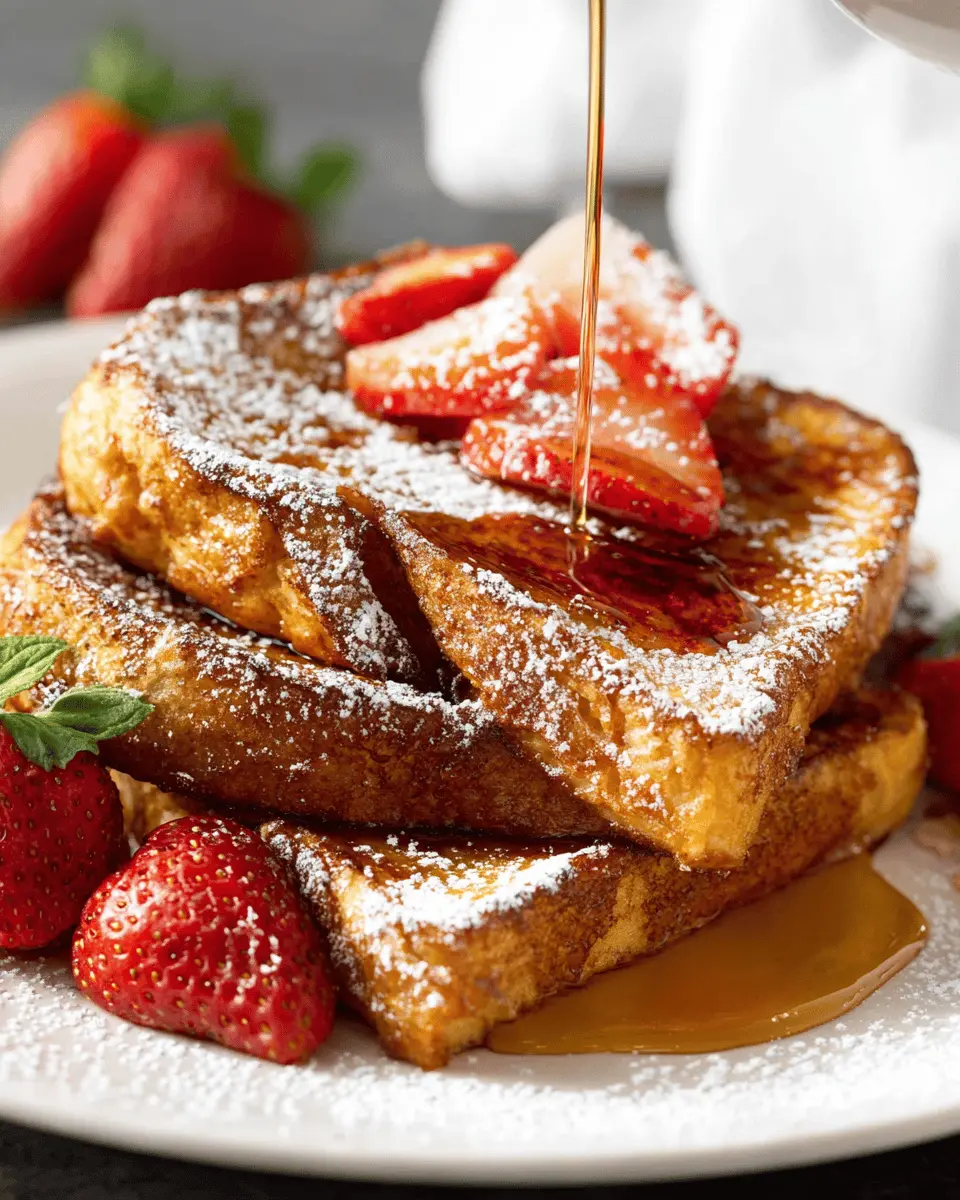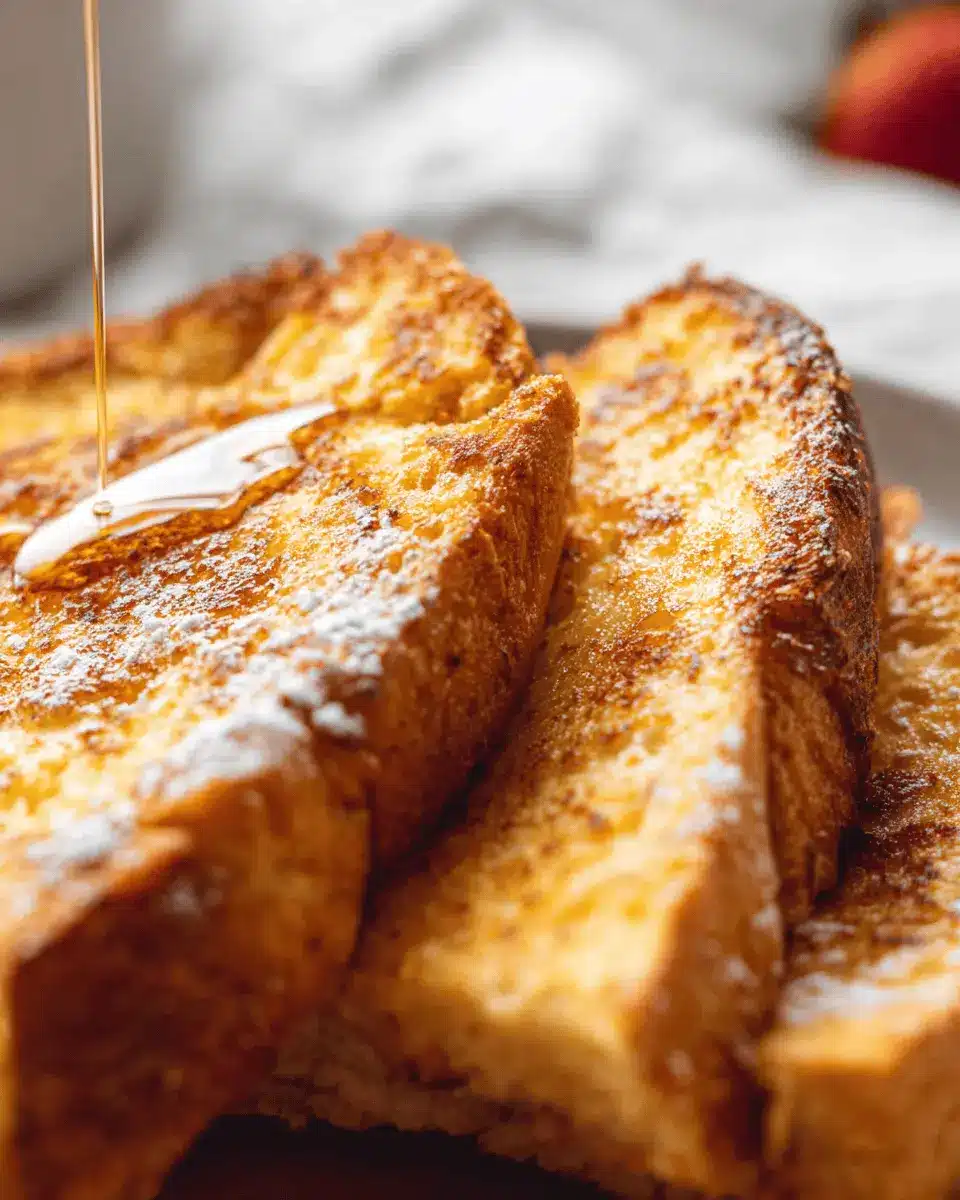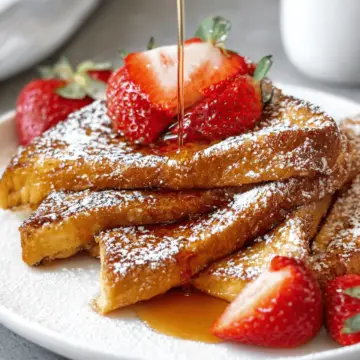Introduction to French Toast
There’s something iconic about French toast that makes it a go-to breakfast option, especially for young professionals. Whether you’ve had a late night at the office or just want to savor a lazy weekend morning, French toast provides a warm, comforting start to your day. Made from simple ingredients—like bread, eggs, and milk—it’s quick to whip up and can be customized to suit your taste.
Why French Toast is the Perfect Breakfast for Young Professionals
As a busy young professional, your mornings are often a whirlwind of tasks and deadlines. French toast is not only a delicious choice, but it’s also highly versatile. You can top it with fresh fruits, a sprinkle of cinnamon, or a drizzle of pure maple syrup for that extra buzz of energy to kickstart your day!
Did you know that breakfast can improve cognitive function and concentration? According to a study published by the American Dietetic Association, individuals who eat breakfast regularly tend to have better overall performance and productivity. So why not treat yourself to a delightful plate of French toast and give your brain the fuel it needs?
Plus, it’s a dish that you can make for yourself or impress friends when hosting brunch. With minimal prep and cooking time, it's definitely a winner in the busy world of young professionals. Enjoy exploring different variations, and don’t forget to share your creations on social media!

Ingredients for French Toast
Essential ingredients for classic French toast
To create the perfect French toast, you'll need a handful of essential ingredients that work together to achieve deliciousness. Start with 8 slices of thick white bread, preferably a day or two old, for the best texture. You'll also need 1 cup of milk, which adds creaminess, along with 2 large eggs and 2 egg yolks for that rich custard base. To bring out the flavors, incorporate 1 tablespoon of sugar, 1 teaspoon of pure vanilla extract, and a pinch of cinnamon and nutmeg. Don’t forget a sprinkle of kosher salt to balance the sweetness. Lastly, use unsalted butter for cooking, and consider having powdered sugar and pure maple syrup on hand for serving.
Options for customizing your French toast
The beauty of French toast lies in its versatility! Feel free to switch up the bread; brioche, challah, or even sourdough can add delightful twists. For a fruity flair, add sliced bananas, berries, or apples into the custard mix or as a topping. If you’re feeling indulgent, consider introducing flavored extracts like almond or coconut. To ramp up the nutrition, swap regular milk for almond or oat milk, making it perfect for dairy-free diets. Check out our article on healthy breakfast options for more ideas on customizing your meals!
Step-by-Step Preparation of French Toast
Making French toast is not only about following a recipe; it’s about creating warm, delicious memories. Let’s walk through how to prepare this classic breakfast dish step by step, ensuring that your French toast comes out perfectly every time!
Drying the Bread for Optimal Texture
Begin with the foundation of your French toast: the bread. If you’re using fresh, soft bread, it can benefit from a little drying. Preheat your oven to 300ºF (149ºC) and line a baking sheet with a wire rack. Lay the bread slices on the rack and warm them for about 10 to 14 minutes. Doing so will create a crispy exterior while keeping that custardy center—a must for perfect French toast. (For more tips on selecting the best bread, you can check this guide on bread types.)
Making the Custard Mixture
Now let's whip up the custard—that rich blend of milk and eggs that gives French toast its luscious texture. In a large, shallow bowl, whisk together:
- 1 cup of milk
- 2 large eggs
- 2 egg yolks
- 1 tablespoon of brown sugar (or granulated sugar)
- 1 teaspoon of pure vanilla extract
- ¾ teaspoon of cinnamon
- ⅛ teaspoon of nutmeg
- ¼ teaspoon of kosher salt
Make sure everything is well combined; the sugar should dissolve completely for that extra touch of sweetness.
Dipping the Bread Slices Efficiently
For efficient dipping, take each dried slice of bread and gently immerse it into the custard mixture for about 15 to 20 seconds per side. Be careful not to let it soak too long; you want it moist but not falling apart! After dipping, use a spatula to carefully transfer the slices to a separate baking sheet while keeping an eye on the custard mixture—give it a quick whisk between batches to ensure an even blend.
Frying the French Toast to Golden Perfection
Heat a nonstick pan or cast iron skillet over medium-low heat. Melt ½ tablespoon of unsalted butter until it bubbles, then add in two slices of bread at a time. Cook until the first side turns golden brown and lightly crisp, about 3 to 5 minutes, then flip and repeat on the other side for another 3 to 4 minutes. The key here is patience—take your time! If you're preparing a large batch, keep the finished slices warm in a 200ºF (93ºC) oven while you finish frying the rest.
Final Touches and Presentation
Once your French toast is all fried up, it’s time for the fun part: presentation! Sprinkle a dusting of powdered sugar on top for that café-style look. Serve immediately with pure maple syrup or your favorite toppings, like fresh berries or a dollop of whipped cream. This is where you can get creative!
Crafting the perfect plate of French toast requires just a bit of care and attention, but trust me, your taste buds will thank you! Enjoy!

Creative Variations on French Toast
French Toast with Seasonal Fruits
Elevate your French toast by adding a vibrant touch with seasonal fruits. Think juicy strawberries in spring, sweet peaches during summer, or cozy spiced apples in the fall. Simply sauté your chosen fruits in a bit of butter with a sprinkle of cinnamon to enhance their flavor before serving them atop your golden toast. For an extra layer of indulgence, drizzle with honey or a dollop of Greek yogurt, creating a delightful balance of sweetness and creaminess.
Savory Spins: French Toast with Turkey Bacon or Chicken Ham
If you’re craving something more savory, try French toast topped with crispy turkey bacon or tender chicken ham. Give your toast a savory twist by infusing the egg mixture with herbs like thyme or basil before dipping your bread. The combination of rich, hearty flavors transforms this classic dish into an enticing breakfast option. Embrace the unexpected, and serve it alongside fresh avocado or a sprinkle of cheese for a satisfying meal that will have your taste buds dancing.
Consider exploring more fun options like baked French toast or stuffed French toast for even more delicious variations.
Cooking Tips and Notes for French Toast
Ensuring the Perfect Custard Consistency
To achieve that dreamy, custard-like consistency in your French toast, be sure to whisk together your eggs and milk thoroughly. A good ratio is essential; the combination of whole eggs and egg yolks enhances richness. You want the mixture to be smooth and slightly thickened—if it’s too runny, your toast won't have that luscious center!
Best Types of Bread for French Toast
Choosing the right bread can elevate your French toast experience. Opt for thicker slices, like brioche, challah, or Texas toast, which soak up the custard beautifully without falling apart. These types offer a delightful balance of crispy edges and soft centers. If you're looking for tips on the best bread choices, check out some expert insights from Serious Eats.

Serving Suggestions for French Toast
To truly elevate your French toast experience, consider a variety of delightful toppings. Fresh berries, bananas, or caramelized apples can add a burst of flavor and color. Drizzling with honey or a rich chocolate sauce can also create a sweet twist. For added texture, sprinkle chopped nuts or granola on top—yum!
Pairing drinks to complement your breakfast
A refreshing drink can complete the perfect breakfast. Enjoy your French toast with a classic orange juice or a creamy vanilla latte. Don't forget about herbal teas or a vibrant smoothie, which can provide a nutritious boost while balancing out the sweetness of your meal. Explore options to find your favorite breakfast pairing!
Time Breakdown for French Toast
Planning your French toast adventure? Here’s a quick breakdown to help set your expectations.
Preparation time
Get everything ready in about 30 minutes. This includes drying the bread and whipping up that delicious custard mixture.
Cooking time
The cooking process will take around 50 minutes, allowing each slice to achieve that perfect golden brown.
Total time
In just 1 hour and 20 minutes, you’ll have a delightful breakfast ready to wow your family or friends. Enjoy every scrumptious bite!
For further insights on perfecting your breakfast skills, check out resources from The Kitchn or Serious Eats for expert tips!
Nutritional Facts for French Toast
Calories per serving
Each serving of French toast packs about 138 calories, making it a delicious yet manageable treat to start your day.
Key nutritional benefits
This breakfast favorite is a delightful source of protein, providing 6 grams per serving. You'll also benefit from essential vitamins like Vitamin A and Calcium, contributing to strong bones and overall health. With the right toppings, it can be easily customized to fit various dietary needs. Consider pairing it with fresh fruit or yogurt for a nutritional boost!
For more in-depth information on how different toppings can enhance the nutritional profile, check out resources from the USDA FoodData Central.
FAQs about French Toast
How can I make French toast crispy?
To achieve that perfect crispy exterior, opt for slightly stale bread or toast fresh bread until it's dried out, as this prevents sogginess. Additionally, cooking on medium-low heat helps develop a golden crust without overcooking the inside. Consider sautéing in a mix of butter and a bit of oil—this not only enhances flavor but helps achieve that delightful crunch.
Can I prepare French toast in advance?
Absolutely! For busy mornings, you can prepare the custard mixture a day ahead and store it in the refrigerator. Simply soak the bread right before you plan to cook it. If you have leftover slices, they can be refrigerated for up to three days or frozen for up to three months. Just reheat using a toaster or oven until warmed through.
What are some common mistakes to avoid?
Avoid using overly soft or fresh bread, which can lead to a soggy texture. Another common pitfall is not allowing the bread to soak long enough in the custard—15 to 20 seconds per side is ideal. Lastly, frying on too high a heat can burn the outside before the inside cooks through. For expert tips, check out more guidance from Serious Eats.
Conclusion on French Toast
Recap on Why Homemade French Toast is a Better Choice Than Fast Food
Homemade French toast not only offers a delightful flavor but is also a healthier choice compared to fast food options. Control your ingredients for a fresher, customizable breakfast—there's nothing quite like preparing this classic dish in your own kitchen. Treat yourself and elevate your mornings with this delicious recipe!

French Toast Delight: Indulgent Twist with Turkey Bacon and Chicken Ham
Equipment
- Nonstick pan or cast iron skillet
- Baking sheet
- Wire rack
- Large shallow bowl
- Spatula
Ingredients
- 8 slices white bread ⅔ to ¾" thick
- 1 cup milk (240 ml)
- 2 large eggs
- 2 large egg yolks
- 1 tablespoon brown sugar or granulated sugar (10 g)
- 1 teaspoon pure vanilla extract (5 ml)
- ¾ teaspoon cinnamon
- ⅛ teaspoon nutmeg
- ¼ teaspoon kosher salt (1 g)
- 2 tablespoons unsalted butter (30 g)
- ¼ cup powdered sugar (24 g)
- 1 cup pure maple syrup (240 ml)
Instructions
- Dry the Bread - If using soft, fresh bread, set the oven rack to the middle position and preheat to 300ºF (149ºC). Place the slices on a wire rack set on a baking sheet. Warm the bread until dry to the touch but not browned, about 10 to 14 minutes, flipping halfway through.
- Make the Custard - In a large shallow bowl, whisk together the milk, eggs, egg yolks, brown sugar, vanilla, cinnamon, nutmeg, and salt.
- Dip the Bread - Soak the bread for 15 to 20 seconds on each side. Use a spatula to transfer to a separate baking sheet. Whisk the custard as needed in between batches to keep the ingredients mixed. Sprinkle more cinnamon on top if desired.
- Fry the Bread - Heat a 12-inch nonstick pan or cast iron skillet over medium-low heat. Melt ½ tablespoon of butter until it bubbles. Add two pieces of bread at a time. Cook until the first side is golden brown and lightly crisp, about 3 to 5 minutes. Flip and cook the other side until golden, about 3 to 4 minutes.
- To Serve - Right before serving, sprinkle powdered sugar on top. Serve with maple syrup or desired toppings.

Leave a Reply